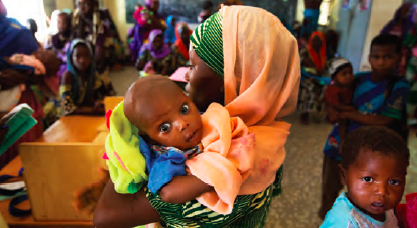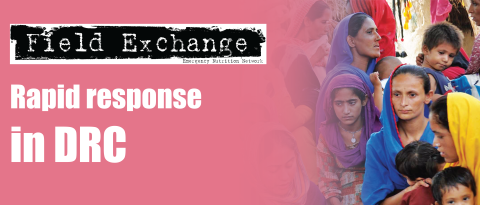Cost analysis of the treatment of severe acute malnutrition in West Africa
Summary of Research
Isanaka S, Menzies NA, Sayyad J, Ayoola M, Grais RF and Doyon S. (2016). Cost analysis of the treatment of severe acute malnutrition in West Africa. Matern Child Nutr, doi: 10.1111/mcn.12398
Location: Niger
What we know: Perceived high cost of SAM treatment and limited evidence on true costs impede scale-up.
What this article adds: A recent study using Médecins Sans Frontières (MSF) nutrition programme data provides updated empirical estimates of SAM treatment costs. Overall cost per child treated was €148.86, substantially lower than previously published values. Outpatient cost was €75.50 per child, dominated by therapeutic food (44%) and personnel costs (35%). Inpatient cost was €134.57 per child, dominated by personnel (56%). As a high-cost input, investigation of cheaper, ready-to-use therapeutic food (RUTF) formulations and reduced dosage treatment remains a priority. Sensitivity analyses suggest total cost could decrease with less dependence on external personnel, integrated programmes in health systems, and increased programme scale; effectiveness of such approaches needs to be evaluated. A high proportion of cases (43%) were managed as more costly inpatients, emphasising the importance of early case detection to reduce overall costs.
 This community-based approach to manage acute malnutrition is recognised as one of the 13 “high-impact” nutrition interventions for its potential to save lives (Bhutta et al, 2008) and is included in the package of key interventions promoted by the Scaling Up Nutrition movement. However, access to SAM treatment remains unacceptably low, with only 7-13% of children with SAM receiving treatment in 2012 (UNICEF et al, 2012). A fundamental obstacle to increasing programme coverage is the perceived high cost of treatment. This study was undertaken to generate updated estimates of SAM treatment costs. Data were collected from a Médecins Sans Frontières (MSF) nutrition programme in Niger and per-patient costs for SAM treatment were estimated, as well as expenditure shares for major cost categories. The authors also present sensitivity analyses to explore costs that may be realised with different input prices and two hypothetical delivery scenarios.
This community-based approach to manage acute malnutrition is recognised as one of the 13 “high-impact” nutrition interventions for its potential to save lives (Bhutta et al, 2008) and is included in the package of key interventions promoted by the Scaling Up Nutrition movement. However, access to SAM treatment remains unacceptably low, with only 7-13% of children with SAM receiving treatment in 2012 (UNICEF et al, 2012). A fundamental obstacle to increasing programme coverage is the perceived high cost of treatment. This study was undertaken to generate updated estimates of SAM treatment costs. Data were collected from a Médecins Sans Frontières (MSF) nutrition programme in Niger and per-patient costs for SAM treatment were estimated, as well as expenditure shares for major cost categories. The authors also present sensitivity analyses to explore costs that may be realised with different input prices and two hypothetical delivery scenarios.
The analysis was based on MSF programme data from Madarounfa, Niger, where standalone SAM treatment is provided in parallel with basic paediatric care (not costed) within the routine health system. Services are delivered at or close to established basic health service facilities but with dedicated personnel, physical infrastructure and other resources. In 2013, the nutrition programme included five health centres for outpatient treatment and one hospital for inpatient care.
Total and per-child costs were calculated from a provider perspective. Costs were categorised into three main activities (outpatient treatment, inpatient treatment and management/ administration) and four cost categories within each activity (personnel, therapeutic food, medical supplies and infrastructure and logistical support). For each category, total costs were calculated by multiplying input quantities expended in the MSF programme during a 12-month study period by 2015 input prices. All children received outpatient treatment; 43% also received inpatient treatment. National-level support costs (such as guideline development and advocacy) were excluded. Also excluded were community screening and mobilisation costs for active case-finding and treatment of moderate acute malnutrition (MAM), and costs borne by households (transportation, food purchases and productivity losses related to treatment).
Results
The overall cost of SAM treatment was €148.86 per child treated. The outpatient cost was €75.50 per child. Two costs predominated here: therapeutic food (44%, €32.98 per child) and personnel (35%, €26.70 per child). Personnel costs were dominated by medical staff, where expatriate and national medical staff contributed €10.01 (13%) and €12.63 (17%) per child respectively. Approximately €1 per child (1%) of outpatient care was attributed to routine treatment, while the cost per child was €7.14 for non-routine medical treatment and supplies and €7.66 for infrastructure and logistical support (each approximately 10% of outpatient costs). Heterogeneity in outpatient costs was observed between sites, with total outpatient cost per child ranging from €49.71 for a site with 8,321 admissions per year to €140.56 for a site with 996 admissions per year.
A simple logarithmic cost curve relating outpatient volume to outpatient costs implied substantial economies of scale, with total costs increasing by 5.3% (and average costs declining by 4.3%) for every 10% increase in client volume, largely due to lower per-child personnel costs in high-volume sites. The inpatient cost was €134.57 per child. Personnel accounted for the largest portion of inpatient costs (56%, €75.47 per child), followed by transport and logistical support (18%, €23.57 per child) and non-routine medical treatment and supplies (16%, €21.19). Therapeutic food contributed 11% of inpatient costs (€14.34 per child). Management and administration costs per child were €40.38, with 76% (€30.63 per child) attributed to personnel and infrastructure and 23% (€9.18 per child) to logistical support.
Sensitivity analyses suggested that reductions in input prices of medical treatments and therapeutic food had limited effect on total costs per child, while increases in programme size/coverage and the substitution of expatriate medical staff with national staff lowered total costs per child substantially (€99.60 and €96.31 respectively vs. €148.86 in the base case). Hypothetical scenarios representing typical vertical and integrated government-supported SAM treatment programmes yielded further important cost reductions (€74.23 and €42.49 respectively vs. €148.86 in the base case).
Discussion
The most important cost driver in outpatient care was ready-to-use therapeutic food (RUTF). As a high-cost input, development of cheaper formulations through local production and/or use of indigenous food sources have been considered. The cost of locally produced RUTF would be context and even producer-specific, as final costs depend on the cost of ingredients, production volume, supplier agreements, demand and packaging. Potential benefits of local production include: readily accessible stock in case of emergency; lower transport costs; and local economic benefits. However, recent experiences show local production ingredient costs can remain high, given import and local taxes, and potential cost savings may be limited by lower production volumes. Ongoing operational research is needed to understand the cost-effectiveness of a reduced RUTF dose in outpatient SAM treatment.
Sensitivity analyses suggest that the total cost of SAM treatment could decrease with less dependence on costly external personnel and increased programme scale. As outpatient services are provided by clinical teams of fixed size, once a clinical team is in place, admissions can increase until teams reach capacity, with little additional expense beyond the extra costs of RUTF and medical supplies. Thus, higher-volume service outlets will likely experience lower average costs per child. Development of national capacity, including training of nurses and community health workers, may reduce programme costs associated with external support. Strategies that increase scale and patient volume (for example by reducing the frequency of visits of the same child from weekly to biweekly or monthly follow-up or by increasing coverage through enhanced community case-finding) may also reduce per-child and total costs.
In this setting, 43% of children required more costly inpatient care, suggesting a high burden of complicated cases. Models that support early identification of children before complications develop (for example through integrated SAM/MAM treatment or improved community case-finding) may also reduce overall programme costs.
The analyses of hypothetical scenarios suggest that SAM treatment costs could decrease substantially with less dependence on costly external expertise and with integration of SAM treatment into existing health services. The effectiveness of such models, however, has not been evaluated and additional costs for increased supervision and support may be necessary to maintain adequate levels of effectiveness in government-supported programmes. Cost-effectiveness of such experiences should continue to be assessed.
In conclusion, the authors present updated empirical estimates of SAM treatment costs that are substantially lower than published values. Sensitivity analyses suggest costs can be driven down further in programmes operating at scale and when integrated into existing health systems. Additional evidence on SAM treatment costs would be valuable, considering possible avenues of further cost reduction and variability in costs across contexts and delivery models.
References
Bhutta et al, 2008. Bhutta ZA, Ahmed T, Black RE, Cousens S, Dewey K, Giugliani E … Shekar M. (2008). What works? Interventions for maternal and child undernutrition and survival. Lancet, 371, 417–440.
UNICEF et al, 2012. UNICEF, Coverage Monitoring Network & ACF International. The state of global SAM management coverage 2012. New York & London: International.


